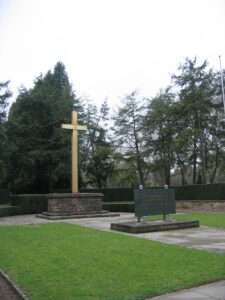With the Old Cemetery in the city centre, the Bad Godesberg Castle Cemetery and the Poppelsdorf Cemetery, Bonn has three outstanding burial sites due to their significance, ambience or location. If you add to this the village churchyards in some districts that are still preserved and date back even further, Bonn’s cemetery landscape is almost worth a trip. This historical heritage overshadows the more modern facilities.

Photo: A. Savin
Thus, Bonn’s largest cemetery by far, the Nordfriedhof on Kölnstraße in today’s Auerberg district, is perhaps the Cinderella of cemeteries. Opened in 1884 as the official successor to the Old Cemetery, which could no longer be expanded, the Nordfriedhof got off to a bad start mainly due to its location. More than three kilometres from the centre of Bonn, it was on the far northern outskirts of the city. It only received a rail connection in 1906, when the Rheinuferbahn (Rhine bank railway) started operating. In the first decades of its existence, it was located in an open field. On the way there, you passed the smouldering rubbish heap where today’s Sportpark Nord is located, the Rheinische Provinzial-Irrenanstalt (today the LVR-Klinik Bonn), the Städtische Hilfshospital für Geisteskranke, Epileptiker und Trunksüchtige (a municipal hospital for the mentally ill, epileptics and alcoholics) and the orphanage and correctional home, which was located on the former site of the leprosarium (an isolation ward for infectious diseases). And contemporaries were certainly also aware that the cemetery area included the former place of execution with the gallows and the Schindanger, where animal carcasses that could no longer be used were disposed of. It is therefore not surprising that the so-called ‘better circles’ at the time sought burial sites elsewhere. After 1905, this was also officially possible. Those who lived ‘west of the railway’ could be buried in the cemetery of the recently incorporated Poppelsdorf. The inhabitants of the southern and western parts of the city made ample use of this opportunity. The Nordfriedhof thus became the cemetery for the city centre and the northern part of the city. Accordingly, the names of the families buried here that are significant in local history are linked to this part of the city. The graves of professors and wealthy individuals were buried mainly in the Poppelsdorf Cemetery, as were those of many of Bonn’s dignitaries.
Nevertheless, the North Cemetery gradually gained its place in the Bonn cemetery landscape. It changed for the better as a park, designed in an exemplary manner including a large chapel added in 1913. Its subsequent three expansions prove that it has become a popular cemetery. Even the reckless handling of some of its remnants could not prevent this. In the 1960s, for example, rows of gravestones were cleared when the main entrance was widened, and the neo-Romanesque gate was demolished. As a result, the list of ‘preserving-worthy’ grave monuments is short compared to the size of the cemetery.
The character of the Nordfriedhof as a cemetery of honour represents a special chapter. The beginnings of this development lie in the First World War. Today, not only the German victims of two world wars are buried here, but also numerous forced and foreign labourers as well as prisoners of war. Initially a place of local remembrance, the war cemetery and cemetery of honour became the central ‘Memorial of the Federal Republic of Germany for the Victims of War and the Victims of Tyranny’ in 1980 (today in Berlin at the Neue Wache). At that time, the bronze plate designed by Hans Schwippert – known as the architect who converted the Pedagogical Academy into the Bundeshaus and Palais Schaumburg into the Federal Chancellery – was transferred from the Hofgarten to the Nordfriedhof for this purpose. One of the more embarrassing chapters in Bonn’s history is that in 2017 it was stolen and replaced by a copy in sandstone.
As a relatively modern cemetery, the Nordfriedhof was not consecrated by a Catholic priest and was not bound to historical structures. Therefore, it reflects the developments that have shaped the funeral industry in the recent past better than many older cemeteries and those that are subject to preservation orders that restrict them to an earlier state. For example, a Yazidi cemetery is integrated into the Nordfriedhof. There are graves where the Greek Orthodox or Russian Orthodox rites were observed, as well as an area for children who died in the womb or at birth. And since 1990, it has had an Islamic burial ground.
A walk through the Nordfriedhof Cemetery is therefore not so interesting if you are interested in art, historically significant graves and famous names. Rather, it is a generously laid out park that reflects the social structure of Bonn city centre and the north of Bonn. Nevertheless, exciting discoveries are not out of the question. For example, there are three graves of members of the Sikh religious community who came to Bonn with the British occupation troops after the First World War. Or the grave of the singer and entertainer Fereydun Farrochsad, who was murdered in Bonn in 1992 in the name of the Islamic revolution in Iran.
Furthermore, the Nordfriedhof is of ecological interest. It has remarkable trees and, due to its size, a wide variety of animal and plant life. With the support of the Rotary Club, the city of Bonn is using it as an experimental area for ‘future trees’ – as a ‘climate grove’.
It is to be hoped that the restoration work on the cemetery chapel, which has been going on for two years now, will finally be completed. Until then, funeral services are held in an unworthy plastic tent. The North Cemetery is still worth a visit!
